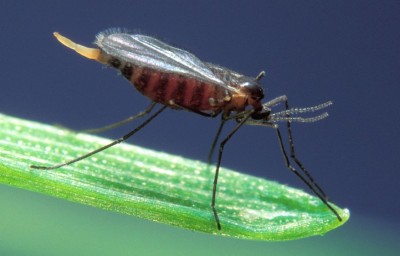Consider Planting Winter Wheat After the Hessian Fly-Free Date
Joshua Putman, Field Crops and Forage Specialist
Southwest New York Dairy, Livestock and Field Crops Program

As fall approaches, growers should consider the recommended timing for planting winter wheat. For years, the standard recommendation for profitable wheat production in New York has been to plant wheat after the Hessian fly-free date. This recommendation is based on the fact that Hessian fly adults would no longer be alive as there are no remedial measures available to save an infested crop. An article prepared by Ken Wise, with the New York State Integrated Pest Management Program, discusses the recommend timing to plant wheat to avoid injury from the Hessian fly as well as a detailed description about this pest. For more information about winter cereal production, contact Josh Putman at 716-490-5572 or jap473@cornell.edu.
Hessian fly, Mayetiola destructor, is a species of fly that is a significant pest of cereal crops including wheat, barley and rye. Hessian flies emerge in late summer, mate, and then lay eggs in different types of grasses - among them wheat. The adult life span is extremely short, perhaps only a week, during which time they do not even feed. After this short time span, adults die off.
The larvae of this small insect feed between the stem and leaf sheath near the base of the plant in newly established wheat in the fall and again in the spring. Damage during the fall causes stunting of the new plants; the spring and early summer damage results in unfilled heads and fallen straw. Look for the small white maggots and brown puparia (the resting stage, commonly called "flax seeds", for their resemblance to the flat spindle- shaped seeds of flax) deep within the sheaths of the lower leaves in the weeks just before wheat harvest.
The fly-free date is set at a time when it is expected that the adults have died and are no longer around the area. As a result, damage caused by this insect will likely be much less if wheat is planted after the specific fly-free date in your area. Note the dates shown on the map are adjusted for altitude (i.e. higher elevations = earlier Hessian fly-free dates). The recommendation is to plant wheat only after the fly-free date for your area but as soon after that date as possible. In Southwest NY, the fly-free date ranges from August 29th - October 6th, depending on county and elevation. In general, September 15th has been a good starting point in Western NY.
Field Crop Chronicle - 9/10/20 (pdf; 1093KB)
- Hessian Fly
Upcoming Events
WEBINAR - Automated Milking Systems Efficiency: Balancing Focus on Individual Cows and System Optimization
May 8, 2024
Please join Cornell the SWNY team and MSU Extension for our talk with Dr. Pablo Silva Boloña on improving efficiency of Automated milking systems by focusing on milking settings for individual and group success.
Broiler Field Day at Sunny Cove Farm
June 6, 2024
Alfred Station, NY
Join us for a field day to explore broiler production, processing, and finances. Meghan Snyder of Sunny Cove Farm will be our host. She raises small batches of organic broilers, processing them on-farm under the 1,000 bird exemption.
Stockmanship and Stewardship 2024
October 25, 2024
Hamburg, NY
Save the date!! The event is one of 4 across the US and is a two-day educational experience featuring low-stress cattle handling demonstrations, Beef Quality Assurance educational sessions, facility design sessions, and industry updates.
Announcements
No announcements at this time.





